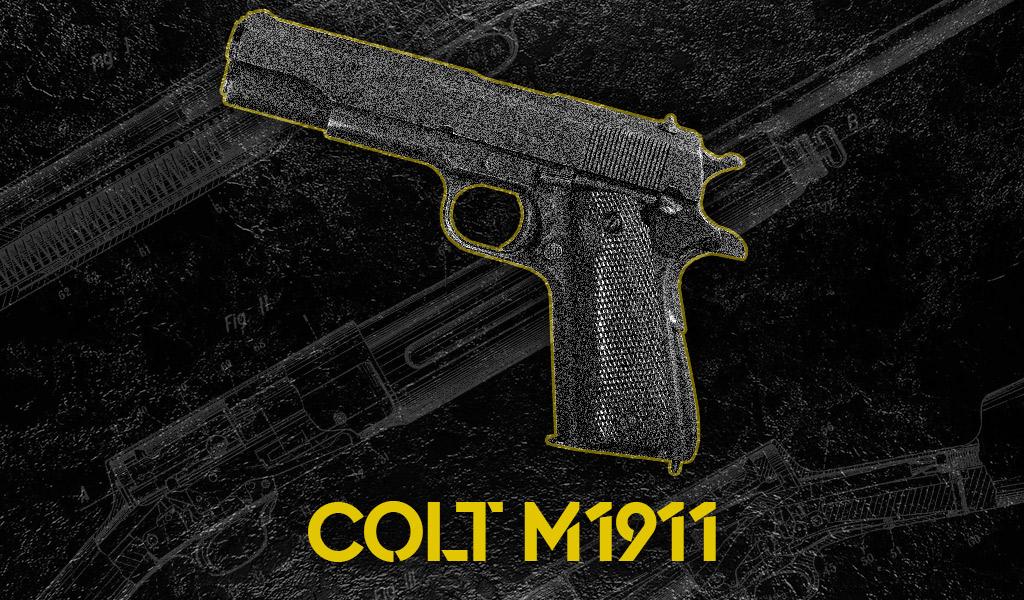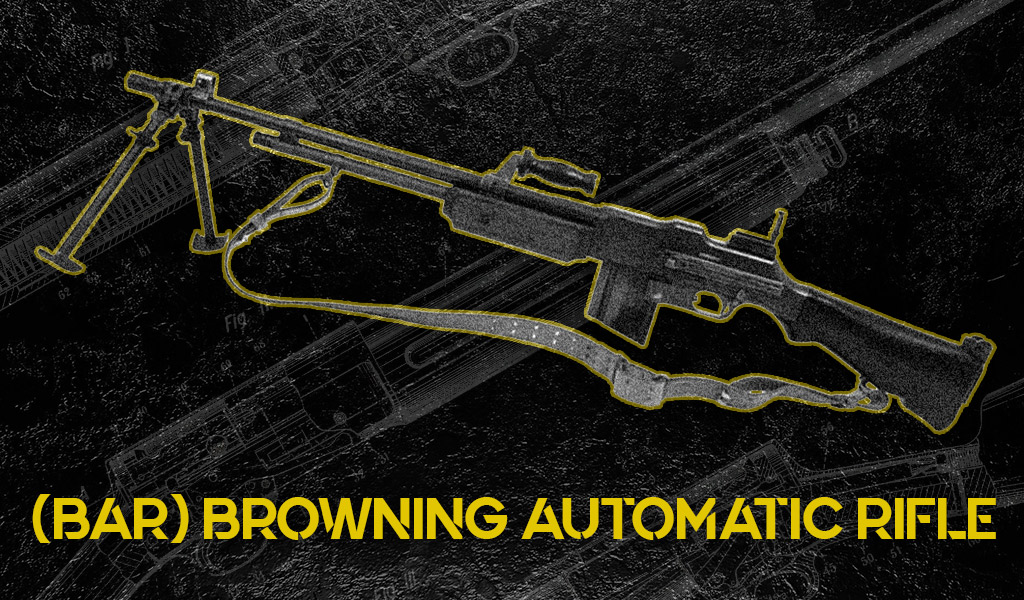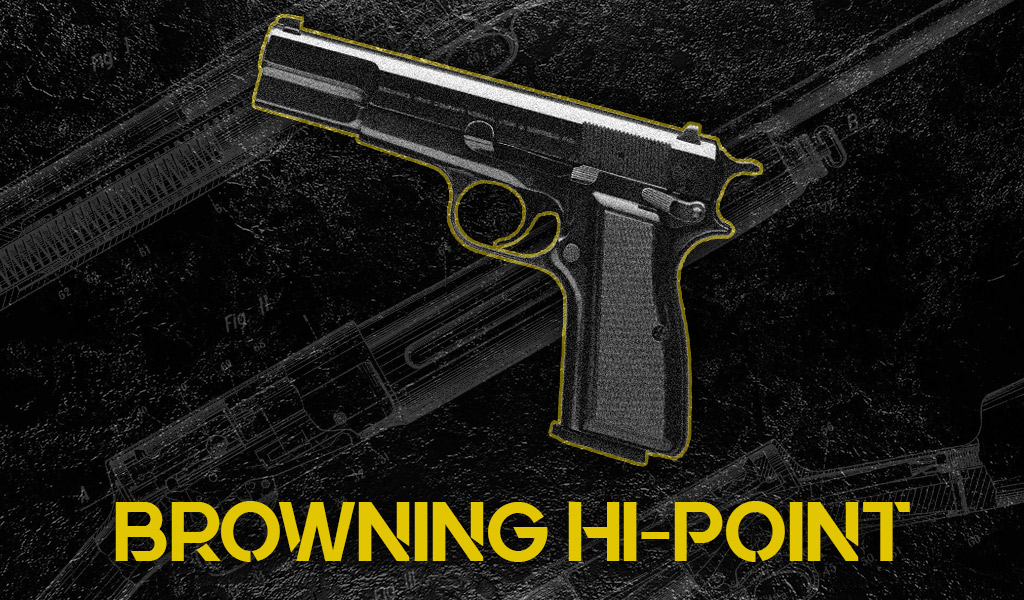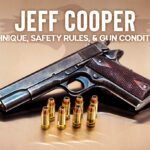

The thumbprint, and trigger fingerprint, of John Moses Browning, is on nearly every major firearm design of the 19th and 20th centuries. A veritable fount of weapon designs, Browning’s innate skills, and pure determination at being a self-motivated marketer of his own works have made him a legend not only of the American shooting world, but globally. To many, he remains a paragon of the American spirit: born of humble origins built into a name of worldwide recognition through his own efforts and tenacity.
Considering the number of designs Browning contributed to the world of firearms it is difficult for many to accept that it was, in fact, one mind responsible. He registered 128 patents with the US Patent Office, and this does not include his numerous adjustments and improvements or the cartridges he specifically developed. He was a veritable Da Vinci of gun design, apparently motivated by a belief that improvement was a constant, never a finish line.
Browning’s Beginnings
John Moses Browning was one of 19 children born to a Mormon pioneer, Jonathan, and Elizabeth Caroline nee Clark, of his father’s three concurrent wives. While much can, and has, been said of the Mormon faith in its early days, one point that cannot be denied is that it created strong, even persistent characteristic in its early adherents: not the least of which being an apparent bearing of self-confidence, or at least assuredness.
Mormon Migrations
The murder of the Mormon Church in Nauvoo, Illinois put those characteristics to the test on June 27, 1844. Many Mormons feared further acts of violence and moved west under the leadership of Bringham Young. Jonathan Browning was among those Mormon migrants who, beginning in 1846, left persecution in Illinois to face the hardship in the wilds of Utah.
It was several years before the Brownings reached Utah. Instead, Jonathan remained in Council Bluffs, Iowa for six years: reportedly stationed there by Bringham Young to help outfit the Mormons as they moved further west. This was reportedly because Jonathan Browning’s skills as a blacksmith were devoted to the art of gun making. By many accounts, he was a very good one at a time when a firearm was well nigh a necessity against all evils and not always easy to come by on the frontier.
To the Mormons striking out west to their new promised land, such evils included hunger and predators. Defense against the attacks from animals or gentiles was foremost on many a Mormons’ minds given the open hostility expressed towards them after their founder’s death.
Joining The Family Business
With the Trail well-blazed and a growing community in and around Salt Lake, Jonathan was finally called west in 1852. He ultimately settled in Ogden, Utah. There, he rebuilt his gun shop staffed by, among others, his not so inconsiderable quantity of sons. The Brownings explored several innovative designs in their shop. Including a repeating black powder rifle that fired from a block of pre-loaded charges that could be processed through the breach of the barrel like the carriage of a typewriter. This was a very fertile environment in which the mind of young John, born January 23, 1855, could and did take root and contemplate the creation of many new designs.
By the age of seven, John Moses Browning was already in his father’s shop learning basic engineering concepts. His family encouraged him to explore new projects and ideas. It is reported that by the age of 10 he had built his first firearm and a very few short years after built of his own design a single-shot rifle firing the newly invented self-contained cartridge.
At 24 he married Rachel Child and shortly after fulfilled his duties to the Church by going on a two-year mission: in his case to Georgia, to spread the word of the Latter Day Saints. Upon the successful conclusion of his mission he returned to the family shop in Ogden and resumed his attention to gun innovations. His brothers were still directing the production of the single-shot rifle Browning designed in the shop.
Partnership With Winchester
Browning’s single-shot rifle caught the attention of the Winchester Repeating Arms Company and around 1883 the company sent an agent out to Utah to investigate the possibility of acquiring the design and patent. The agent knew a good thing when he saw it and purchased the rifle design from Browning for a flat fee. Winchester manufactured this design and distributed it far beyond the Brownings’ own capabilities could ever consider. It became the Winchester 1885, available in both Low Wall (low powered cartridges) and High Wall (with a heavier receiver for higher pressure loads) variants.
The agent also realized that John Moses Browning was no mere one-hit-wonder. At the same time as acquiring the single-shot rifle rights, Winchester purchased the designs Browning was working on for a stronger lever-action rifle that could fire more powerful rounds than what Winchesters were already chambered in: this, with some final amendments, became the Model 1886 Winchester.
In all, Browning ultimately provided the designs, in all or part, for many of the popular Winchester firearms at the close of the 19th century (and after) including the aforesaid 1886, the 1892, 1894 and 1895 rifles as well as the Model 1897 shotgun. All of which were sold to Winchester for a flat fee which seemed to work very well for all concerned. After noting the prominence of his designs not only over the West but elsewhere Browning discerned that it worked far better for Winchester than for him.
New Frontiers In Weapon Design
While many of the early longarm designs Browning had created went to Winchester, he had also been working on other projects, including handguns and handgun cartridges. He sold most of these to Colt or entities overseas. By the late 1890’s he was also exploring self-loading firearms for both automatic and semi-automatic performances. Yet the primary money maker continued to be sporting arms. When he perfected his design for a self-loading shotgun, he decided that it was worth more than the standard flat fee Winchester typically offered.
In 1898, Browning introduced to Winchester the design idea for his long recoil-operated shotgun. It was among the first of its kind, and it was a fair assumption that it would revolutionize the market. Winchester was of course interested, but Browning inserted a change into his proposed contract. Rather than the customary flat fee he wanted a royalty upon each firearm sold. If it did well, again, there was little reason to doubt that it would, he stood to make a considerable fortune above his usual, albeit still impressive, fee.
The Winchester management team was aghast. Perhaps they even felt offended that this Mormon from the desert wastes of Utah would be so presumptuous to even suggest a change of terms. Who did he think he was?
It is quite likely that Browning thought he was the Winchester’s meal ticket. Winchester obviously assumed that they were Browning’s means of support. When the company rejected his proposal, and the new shotgun design along with it, they did so in the confident assumption that he would return in short order, hat in hand, and beg for his usual payment. For his part, Browning chose not to give Winchester the satisfaction.
Self-Loading Pistols
Instead of eating crow in Winchester’s New Haven Connecticut headquarters, Browning returned west to work on several other projects. None of which had anything to do with Winchester. These included the self-loading pistol cartridge: the .32 Browning in 1899 which he sold to Colt (the .32 Automatic Colt Pistol or ACP). He also sold it to an arms company in Belgium, Fabrique Nationale Herstal (FNH), where it became known as the 7.65mm Browning.
Along with the cartridge, he introduced a new pistol design. A straight blowback that had a fixed barrel but the bolt was part of an encompassing slide instead of reciprocating inside of a receiver. He also sold these to Colt and FNH respectively by 1900.
Semi-Automatic For The People
However, semi-automatic handguns were still somewhat of a novelty at the turn of the 19th century and there was not a lot of money in them. The handguns people knew and trusted were revolvers. Militaries knew and trusted revolvers. So did police departments. As of yet, while the designs were practical and reliable, they were not yet popular. The missing Winchester meal ticket may have begun to cause a pinch, but the company still refused to consider a royalty payment basis.
To break the impasse, Browning headed back East. Not to New Haven, Connecticut but to Ilion, New York. At Remington Headquarters he proposed the sale with the same royalty arrangement Winchester refused. Fate, however, rewarded his gumption of playing the big name gun companies against each other with bad timing. Browning was literally waiting to meet with the President of Remington, Marcellus Hartley on January 8, 1902, when the latter dropped dead of a heart attack. One can almost hear the barely restrained snickers of the Winchester executives. What was Browning going to do now?
Unwilling to wait for Hartley’s condition to improve, and damned if he was going to return to Winchester with either his hat or the designs in hand, Browning set off across the Atlantic to talk to some of his Belgian contacts.
The Browning Auto-5 Shotgun
As stated, the state arms maker FNH and Browning were no strangers to each other in 1902. In fact, the Belgians seemed quite happy with the Browning cartridge and little pocket pistol that fired it. When Browning proposed his self-loading shotgun design to FNH, they not only accepted his royalty condition, they even named the shotgun after him. They dubbed it the Browning Auto-5.
Once it hit production it was the first mass-marketed, semi-automatic shotgun in history. It also had one of the most prolific and longest production runs. Once FNH started turning them out Browning was able to secure permission to let other companies purchase a license to copy it. Remington recouped their missed opportunity in 1905, and even Savage produced models later on from 1930-1949. The Auto 5 remained in production throughout much of the 20th century, in fact. Though Winchester did not make a single one.
John Moses Browning: Free Agent
No longer, if ever he was, bound to Winchester, John Moses Browning became a free agent. There was no shortage of companies willing to entertain him or his designs. The new .32 ACP/7.65mm round was just starting to take off. It would be utilized by numerous companies and countries for private, military and police use.
By 1905, the semi-automatic pocket pistol suddenly came into vogue in favor over the revolver. The fact that many metropolitan areas began adopting ordnances against the open wearing of firearms was no doubt a coincidence. Smaller pistol designs simply answered the need to be discrete for social or legal causes.
Ammunition Design
To answer this market demand, Browning introduced one of his most diminutive cartridges, the .25 ACP. The goal was to create a new round that had the size and power of a .22 rimfire. Browning knew it needed a more reliable ignition system, so he made it a centerfire round. The resulting pistol designs of the Baby Browning, Colt Junior and FN1905 pistols all share Browning’s paternity. His 6.35mm cartridge, Europe’s .25 ACP nomenclature, became a common caliber for firearms made in Germany, Austria and Italy as well.
Another cartridge Browning pioneered was the .38 ACP. It is in fact older than the .32 ACP but had not yet found a commercially successful platform. The Colt Model 1900 served as a proving ground for many of Browning’s later successes with Colt. The pistol was large and somewhat underpowered when compared to revolvers of the day. Shooters could load the .38 ACP cartridge to higher velocities, but the pistol itself was incapable of withstanding it. In fact, power seeking pistoleers revisited hotter .38 ACP in the 1920’s. Pistol designs finally caught up to it. They christened the new round .38 Super.
Pocket-Power: The .380 ACP
In the meantime, Browning merged the design specs of his .32 ACP with the .38 ACP. In 1908 he produced what became known as the .380 ACP. This round was deemed the largest cartridge that could practically be used in a blowback pistol. The pistol design requirements were fairly simple to operate and manufacture. The .380ACP, like the .32 ACP before it, became a globally accepted round.
Literally hundreds of pistol designs produced for military police and private use were chambered for it. It was known internationally as the 9mm Browning Short, or the 9mm Corto, or 9mm Kurz. Today it is still considered the smallest competent personal cartridges for pocket pistols.
The Colt 1911
The .38 ACP Colt Model 1900 was submitted to the US Army for testing in 1908. It competed against the Steyr Roth and the Mauser C96 after a tender for a new service sidearm was issued. The Colt tested well. The Army, however, was caught up in a sense of nostalgia. Irritation by reports of their current issue .38 Long Colt’s underperformance in the Philippines were still fresh on their minds. Being generally uncooperative with designers in general, they decided they wanted a larger caliber.
Undaunted, Browning tackled and submitted a design destined for greatness for the military tests in 1910. An improved single-action, semi-automatic, magazine-fed, recoil-operated pistol chambered in his new .45 automatic cartridge. With its successful completion of the stress trials in 1910, the new service pistol was christened the Colt Model 1911. The rest, as they say, is history.
The Machine Gun Blues
The US military had a somewhat curious attitude when it came to automatic weapons. While the military used Gatling guns by the end of the Civil War, their bulk dictated units treat them more as field pieces than infantry weapons. Browning sold one of his earliest self-loading designs to Colt. They manufactured it as the Model 1895. This was a smaller crew serviced weapon that was eminently more portable.
It wasn’t a commercial success after its first recognized deployment. It did, however, earn a nickname during the Spanish American War. Troops on the battlefield called it the “potato digger.” The US Army never officially adopted the Model 1895 beyond deploying it on a prototype basis. Volunteers themselves actually acquired the two that went with Teddy Roosevelt’s volunteers to Cuba. Reports of the weapons’ unreliability mitigated its impact in providing fire support.
The guns simply proved to be a bit finicky in different deployment situations. Leaders attributed this to a number of factors including lack of training, environmental conditions, and incorrect deployment. It was also an imperfect design; overly complicated with a lever-activated gas trap system. A situation that Browning was eager to address in his “spare time.”
The 1895’s lackluster performance did not alter the military’s attitude towards the weapon systems. In fact, many generals appeared to equate the novel concept of covering fire with the admonishment of wasting ammunition.
Back To The Drawing Board
Browning himself, responding to the field reports, improved the design of the fully automatic weapon in 1900. But as no one was buying, it remained on the drawing board until he revisited it again in 1910. Still, no one appeared interested in buying it. The consensus was machineguns simply had no respect for the cost of ammunition. If military leaders felt that way, it was not difficult to think what private buyers thought of the pell-mell spray of lead downrange. Attitudes would have to be encouraged to change by other concerns than just fiduciary costs.
World War I
When World War I erupted in 1914, the gap between 19th-century tactics and 20th-century weapons resulted in unspeakable carnage. Soldiers quickly thwarted bayonet charges with mass concentrations of machinegun fire. Generals who still believed in massed movements of infantry found themselves commanding increasing numbers of raw recruits as violence consistently cut down their soldiers.
By 1917 most of the combatants had learned the hard way how useful automatic gunfire was. It did not waste ammunition as expected, but if generals were not careful it certainly wasted lives. When the Americans arrived in mid to late 1917, their generals, choosing to ignore the warnings of the allies, attacked in massed waves. The result was a loss of men and terrifying casualties. A learning curve was employed and a search for an automatic weapon began in earnest. In the meantime, some of the doughboys were issued shotguns.
Birth of the BAR: Browning Automatic Rifle
Browning’s submitted his new, crew operated machine gun, with a water-cooled design for tests to the US military that Summer. The military adopted it as the Model 1917. However, production delays did not see them deployed to the front before the end of Summer in 1918. In the meantime, the American Expeditionary force made do with weapons from other nations such as the British Hotchkiss and Vickers. Some others were of questionable reliability such as the French Chauchat.
When he submitted the Model 1917 for tests, Browning also introduced a portable automatic rifle. The weapon was light-weight and capable of providing advancing fire, it was presented simply as the Browning Automatic Rifle (BAR). The world adopted it too quickly and it suffered delays because production facilities simply did not exist. Though a limited number of the rifles did make it to the front before the end of the war.
Browning, never one to sit around, worked on other powerhouse designs. Looking to lighten the load of his crew operated weapons, he introduced the .30 caliber Browning Model 1919 by the end of the war. The military and government worked to put the approved designs onto the battlefield.
Interestingly, all three of Browning’s new military rifles were chambered in .30-06. The 63mm length of the .30-06 Springfield cartridge had been considered too long for reliable use in self-loading weapons. Other weapon designers had all but abandoned the cartridge for military use. Proving his genius, Browning had no problem making it work.
Ma Deuce: Browning’s 50 BMG
In fact, in 1921, John Moses Browning began working on an even larger cartridge in an upscaled version of his 1919. The “Ma Deuce” or .50 caliber Browning Machine Gun (BMG) his model M2 heavy machine gun was born. Both the cartridge and gun were approximately a 2X enlargement of his .30-06 firing M1919 design. It remains in active service in the US, and other militaries, to this day as an anti-vehicle and extreme long-range anti-personnel weapon.
Browning Hi-Power 9mm
At the age of 71, John Moses Browning showed no signs of slowing down. The Great War had inaugurated several new designs he was interested in exploring further. One of the most popular modern cartridges, the 9mm Luger, attracted his interest. Despite having not invented it, he endeavored to make a better service weapon to fire it. Introduced in 1902 by Georg Luger, it was as an alternative caliber for his famous pistol. Luger built the 9mm for war, hence the designation, “parabellum.” German soldiers battle tested the 9×19 in the war, giving it the experience to suggest reliability.
On November 26, 1926 Browning was working at his desk in his FNH workshop in Leiges, Belgium. He came in early to explore the merits and attributes he wanted his first 9mm Luger pistol to have. John Moses Browning was found deceased later that morning. He died of congestive heart failure. His body was duly returned and interred in Ogden Utah. FN designer Diedonne Saive continued off the notes Browning was working on. In 1935, the Browning Hi-Power pistol was introduced. Copied both in and out of license, the pistol saw service on the hands of both Allies and Axis in the Second World War.
The Legacy Of John Moses Browning
Winchester, Remington, FNH, Savage, Stevens and numerous other manufacturers with and without legitimate licenses made and sold Browning’s designs. The Browning Arms Company was founded in 1927 and became a subsidiary and American distributor of FNH fifty years later. Around the same time in the mid 70’s FNH began outsourcing the manufacture of the original Browning designs. They, like Winchester, started having their rifles made by Miroku in Japan. The Browning Hi-Power, the company’s most famous centerfire pistol, was made in the US, Canada, Belgium and Portugal. Copies were also made by the Hungarians (FEG) and Israelis (KAREEN) among others.
If imitation is the sincerest form of flattery, the continued use of John’s designs decades after he passed is the most honest form of recognition. John Moses Browning never let a good idea sit on the shelf. People who know firearms never let his designs go to waste (everyone learned from Winchester’s mistake). Browning never let others dictate his worth. If something did not work, he kept at it until it did or he found a way to make what worked work better. A policy he followed literally to his last day on Earth. His tenacity remains his awe-inspiring. It’s the characteristic that made this American pioneer into one of the greatest technical thinkers of the modern age.







